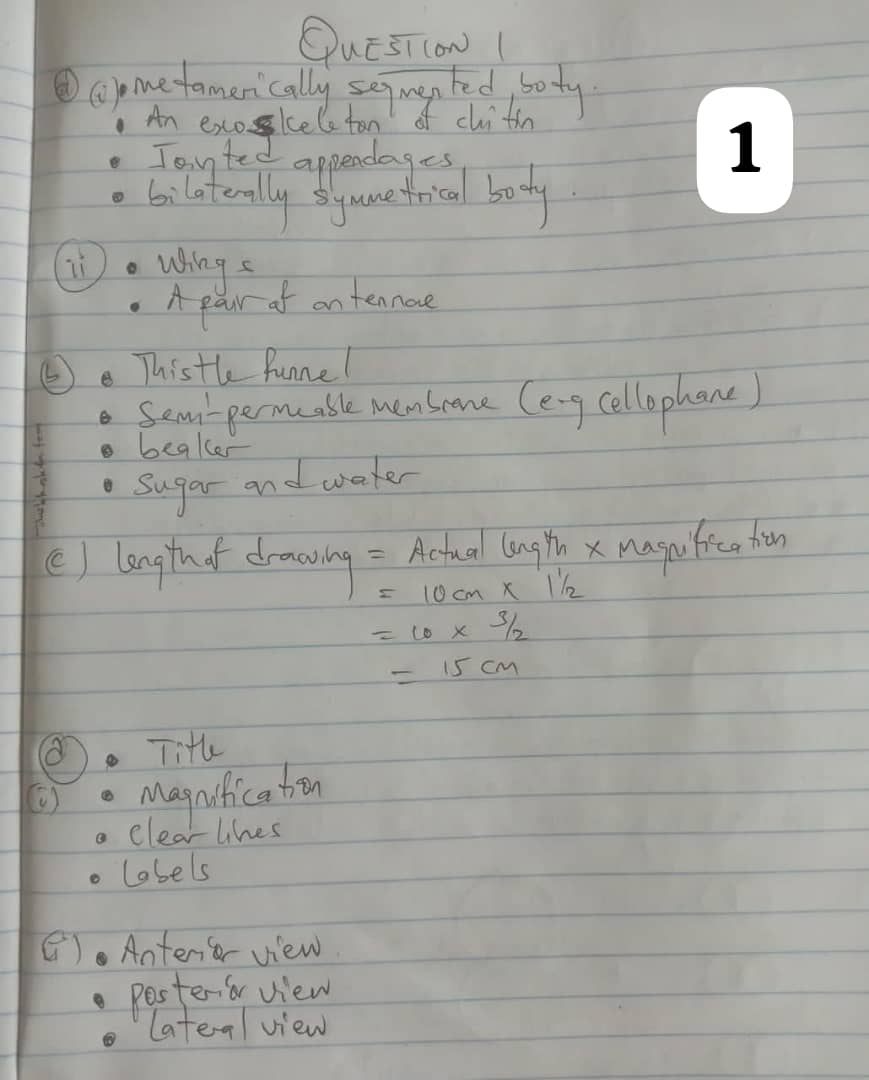2024 WAEC GCE Biology Answer

(2a)
The feces of lizards are more solid than those of mammals due to the differences in their digestive systems. Lizards are ectothermic, meaning they rely on external sources of heat to regulate their body temperature. This slower metabolism allows them to extract more water from their food, resulting in more solid and less watery feces compared to the typically more liquid feces of mammals.
(2b)
(PICK ANY FIVE)
(i) Saliva
(ii) Gastric juice
(iii) Pancreatic juice
(iv) Bile
(v) Intestinal juice (from the small intestine)
(vi) Mucus
(2c)
(PICK ANY THREE)
(i) Pepsin
(ii) Trypsin
(iii) Chymotrypsin
(iv) Elastase
(v) Carboxypeptidase A
(vi) Carboxypeptidase B
(2di)
(PICK ANY THREE)
(i) Both are biological catalysts
(ii) Both are involved in regulating biological processes
(iii) Both are produced by specialized cells or tissues
(iv) Both have a specific target or substrate
(v) Both require specific conditions (temperature, pH, etc.) to function optimally
(vi) Both can be affected by inhibitors
(2dii)
In Tabular Form
=HORMONES=
(PICK ANY THREE)
(i) Act as signaling molecules
(ii) Transported in the bloodstream
(iii) Influence distant target cells
(iv) Regulate complex processes
(v) Act at low concentrations
(vi) Have long-lasting effects
=ENZYMES=
(PICK ANY THREE)
(i) Act as catalysts
(ii) Act locally at the site of their production
(iii) Influence specific chemical reactions
(iv) Facilitate specific metabolic processes
(v) Act at higher concentrations
(vi) Have short-lived effects
(2e)
(i) Glucose – 1 molecule
(ii) Water – 6 molecules
(iii) Oxygen – 6 molecules
*WAEC GCE BIOLOGY*
*NUMBER THREE*
(3ai)
Ecology is the study of the relationships between living organisms and their environment. It examines how living things interact with each other and with the non-living components of their environment, such as air, water, and soil.
(3aii)
An ecosystem is a community of living organisms (plants, animals, and microorganisms) interacting with each other and with their physical environment. The components of an ecosystem are interdependent and form a complex web of relationships.
(3aiii)
The biosphere is the part of the Earth’s environment that supports life. It includes all the living organisms on the planet, as well as the physical environment they inhabit, such as the atmosphere, hydrosphere, and lithosphere.
(3bi)
(PICK ANY TWO)
(i) Producers
(ii) Consumers
(iii) Decomposers
(iv) Abiotic factors
(3bii)
(PICK ANY TWO)
(i) Producers: Organisms that can synthesize their own food, usually through photosynthesis, and form the base of the food chain.
(ii) Consumers: Organisms that obtain energy by consuming other organisms, either directly (herbivores) or indirectly (carnivores and omnivores).
(iii) Decomposers: Organisms that break down dead organic matter, releasing nutrients back into the environment for reuse by producers.
(iv) Abiotic factors: The physical and chemical components of the environment, such as water, air, soil, and sunlight, which provide the necessary resources and conditions for life.
(3ci)
(PICK ANY FOUR)
(i) High species diversity
(ii) Lush vegetation and dense canopy
(iii) Warm and humid climate year-round
(iv) High rainfall (typically over 2,000 mm per year)
(v) Nutrient-poor soil
(vi) Vertical stratification of the vegetation
(3cii)
(PICK ANY TWO)
(i) Tall, straight trunks to reach the canopy and compete for sunlight
(ii) Broad, flat leaves to maximize light absorption for photosynthesis
(iii) Buttress roots to provide stability in the shallow, nutrient-poor soil
(iv) Ability to shed leaves during the dry season to conserve water
(v) Bark that is resistant to fire and pests
(vi) Seed dispersal mechanisms
*WAEC GCE BIOLOGY*
(4ai)
Organic evolution refers to the process by which species of living organisms change over time through variations in traits, inheritance, and natural selection. It is the gradual development of new species from common ancestors through genetic changes and adaptation to their environment.
(4aii)
(i) Fossil Record
(ii) Comparative Anatomy
(iii) Embryology
(iv) Molecular Biology
(v) Biogeography
(4bi)
The Theory of Use and Disuse suggests that body parts or organs that are used frequently become stronger and more developed, while those that are not used may diminish or disappear over generations. The idea is that environmental demands lead to the development or reduction of certain features based on their utility
(4bii)
Jean-Baptiste Lamarck.
(4biii)
(i) Giraffes
(ii) Aquatic organisms (like amphibians and their legs)
(4c)
Mutation refers to a sudden, random change in the genetic material (DNA) of an organism. Mutations introduce new genetic variations in a population. Some mutations are beneficial, giving organisms a survival advantage and thus increasing the likelihood of passing on these traits to future generations. Over time, these beneficial mutations accumulate and contribute to the evolution of new species
(4d)
(i) Aestivation: Lizard
(ii) Basking: Bat
(iii) Territoriality: Monkey
(iv) Hibernation: Polar bear
ALSO READ:�2024 NABTEB GCE Computer Craft Studies Questions And Answers